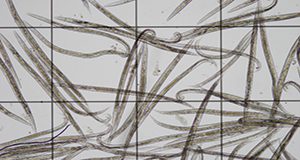Abstract
A small nematode worm commonly referred to as a “microworm”, has been a staple live feed used in the ornamental aquaculture industry for over 50 years. These worms are small enough to be ingested by the larvae of many commonly cultured ornamental species and their production methods are simple and reliable. Microworms have the potential to provide appropriate nutrition in a live feed organism that is cultured entirely in house and involves less labor and cost than newly hatched Artemia. In this article, the biology, environmental requirements, and culture techniques for microworms are discussed as well as their importance for the larval culture of freshwater fish species.
References
Brüggemann, J. 2012. "Nematodes as live food in larviculture-a review." J World Aquacult Soc 43:739-763 https://doi.org/10.1111/j.1749-7345.2012.00608.x
Chappell, J. A. 2013. "Culture Of Microworms (Panagrellus sp.) As An Alternative to Brine Shrimp for Larval Fish Forage." Auburn University:1-3 (https://agrilifecdn.tamu.edu/fisheries/files/2013/09/Culture-O-Microworms-Panagrellus-sp.-As-An-Alternative-to-Brine-Shrimp-for-Larval-Fish-Forage.pdf).
Focken, U., C. Schlechtriem, M. Von Wuthenau, A. García‐Ortega, A. Puello‐Cruz, and K. Becker. 2006. "Panagrellus redivivus mass produced on solid media as live food for Litopenaeus vannamei larvae." Aquacult Res 37:1429-1436 https://doi.org/10.1111/j.1365-2109.2006.01578.x
Hoff, F. H., and T. W. Snell. 1987. Plankton Culture Manual. fifth edn. Florida Aqua Farms, Inc., Dade City, Florida
Kumlu, M., D. Fletcher, and C. Fisher. 1998. "Larval pigmentation, survival and growth of Penaeus indicus fed the nematode Panagrellus redivivus enriched with astaxanthin and various lipids." Aquacult Nutr 4:193-200 https://doi.org/10.1046/j.1365-2095.1998.00071.x
Malla, S., and S. Banik. 2015. "Production and application of live food organisms for freshwater ornamental fish Larviculture." Adv in Bioresearch 6
Ricci, M., A. Fifi, A. Ragni, C. Schlechtriem, and U. Focken. 2003. "Development of a low-cost technology for mass production of the free-living nematode Panagrellus redivivus as an alternative live food for first feeding fish larvae." Appl Microbiol Biotechnol 60:556-559 https://doi.org/10.1007/s00253-002-1178-2
Santiago, C., A. Gonzal, M. Ricci, and S. Harpaz. 2003. "Response of bighead carp Aristichthys nobilis and Asian catfish Clarias macrocephalus larvae to free‐living nematode Panagrellus redivivus as alternative feed." J of App Ichth 19:239-243 https://doi.org/10.1046/j.1439-0426.2003.00454.x
Sautter, J., H. Kaiser, U. Focken, and K. Becker. 2007. "Panagrellus redivivus (Linné) as a live food organism in the early rearing of the catfish Synodontis petricola (Matthes)." Aquacult Res 38:653-659 https://doi.org/10.1111/j.1365-2109.2007.01714.x
Schlechtriem, C., U. Focken, and K. Becker. 2005. "Digestion and Assimilation of the Free‐living Nematode Panagrellus redivivus Fed to First Feeding Coregonid Larvae: Evidence from Histological and Isotopic Studies." J World Aquacult Soc 36:24-31 https://doi.org/10.1111/j.1749-7345.2005.tb00127.x
Schlechtriem, C., M. Ricci, U. Focken, and K. Becker. 2004. "Mass produced nematodes Panagrellus redivivus as live food for rearing carp larvae: preliminary results." Aquacult Res 35:547-551 https://doi.org/10.1111/j.1365-2109.2004.01049.x
Weerasooriya, A., U. Edirisinghe, P. Silva, and C. Dematawewa. 1999. "Feeding behaviour and acceptability of different feeds by Puntius nigrofasciatus." Trop Agricult Res 11: 221-228.
Unless otherwise specified, articles published in the EDIS journal after January 1, 2024 are licensed under a Creative Commons Attribution-NonCommercial-NoDerivs 4.0 International (CC BY-NC-ND 4.0) license.

